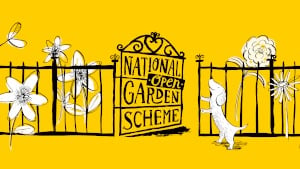About Chawton House
Part of the South Downs National Park, the gardens are a small part of a larger estate belonging to a charitable trust, and are open to visitors.
The grounds and gardens continue to be in the process of restoration although a great deal has already been achieved. The Parkland is restored in the English landscape period of the 18th century, while the gardens have examples of 18th and 19th century Victorian/Edwardian design. Edward (Austen) Knight, Jane Austen’s brother, created the walled kitchen garden, shrubberies and parkland. Edward inherited Chawton House after being adopted by relations Thomas and Catherine Knight, who were childless. We know from Jane’s letters that she was involved with the new plans, but sadly she died before the completion of the walled garden.
Throughout the estate, locally derived native trees and shrubs that were introduced to Britain prior to 1840 are being used as much as possible. The promotion of nature conservation and ecology to create a wide diversity of the land and wildlife habitats remains a constant principle.
The garden is comprised of the South Lawn, in the English Landscape style, complete with Ha-Ha to allow for an uninterrupted vista of the park and grazing animals. The lawn retains its informal character, as originally intended.
Next to the lawn and house, the Library or Lower Terrace was built between 1896 and 1910 by Montagu Knight (1844-1914); the terrace was an Arts & Crafts addition and almost certainly influenced by Edwin Lutyens, whose influence can also be seen inside the house. Follow the Serpentine Gravel Path from here to the Upper Terrace and Fernery, with the Walled Garden just beyond. The Walled Garden contains the Rose Garden, Orchard, Kitchen Garden and Elizabeth Blackwell inspired Herb Garden. In Jane Austen’s time, the kitchen garden was located to the north of the Rectory (opposite the current entrance to Chawton House); Edward (Austen) Knight had the idea to build a new walled garden during his sister’s lifetime, but his plans did not come to fruition until after her death in 1817.
The Wilderness across the South Lawn dates from the late seventeenth and early eighteenth centuries and was originally set out geometrically with trees in straight rows, a practice which was later dropped; it has survived the English Landscape improvements and informal paths were made through the Wilderness in the nineteenth and twentieth centuries.
The South Lime Avenue was planted by Montagu Knight during the second part of the nineteenth century and continues the view across to the parkland, over the Ha-Ha, where the original 1860s fence has been restored and reinstated.
The Parkland is open to visitors and has signposted walks. A tea shed on the main drive to the house and the Old Kitchen Tearoom provide refreshments (check website for offers and opening times).
.
Website:
https://www.chawtonhouse.org
.jpg)
.jpg)
.jpg)
.jpg)
.jpg)
.jpg)
.jpg)
.jpg)
.jpg)
.jpg)
.jpg)
.jpg)
.jpg)
.jpg)
.jpg)
.jpg)
.jpg)
.jpg)


.jpg)
.jpg)

.jpg)